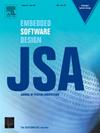WEnSIBR:使用支持编码和区域磨损均衡的动态基进行压缩
IF 4.1
2区 计算机科学
Q1 COMPUTER SCIENCE, HARDWARE & ARCHITECTURE
引用次数: 0
摘要
非易失性存储器(NVM)是取代主存中的DRAM的潜在候选者,但它们在写方面存在一些固有缺陷,如耐久性差、能耗过高和延迟长。由于昂贵的写活动而导致的位翻转会降低内存的生存期。我们提出了SIBR,它在写入内存之前压缩传入的缓存块。压缩块减少了内存单元中的写活动。为了进一步减少位翻转,我们提出了一个名为EnSIBR的SIBR扩展,它以相对较低的存储开销在SIBR生成的压缩块上执行编码。然而,只有一小部分内存(与压缩块相对应)参与写活动,导致内存单元接收位翻转时出现偏差。我们的第二个贡献是线内损耗均衡方法,它将内存线的逻辑分区称为区域。我们使用区域年龄的概念,它表示该区域在一段时间内发生的写次数。我们还考虑了每次写入时区域所经历的位翻转次数。这个名为WEnSIBR的提案,平衡了由SIBR和EnSIBR造成的失衡分布。WEnSIBR的新颖之处在于它能够均匀分布并同时减少比特翻转,这大大提高了NVM的使用寿命。本文章由计算机程序翻译,如有差异,请以英文原文为准。
WEnSIBR: Compression using dynamic bases supported with encoding and zone wise wear leveling for NVMs
Non-Volatile Memories (NVM) are potential candidates to replace DRAM in main memory with a few intrinsic flaws associated with their writes, like poor endurance, excessive energy consumption, and long latency. Bit-flips due to costly write activities degrade the memory lifetime. We proposed SIBR, which compresses the incoming cacheblocks before writing in memory. Compressed blocks lead to lesser write activities in the memory cells. For further bit-flip reduction, we propose an extension of SIBR called EnSIBR that performs encoding on the SIBR-generated compressed blocks with relatively low storage overhead. However, only a small portion of memory, corresponding to the compressed block, is involved in write activity, leading to skewed bit-flip reception by memory cells.
Our second contribution is an intra-line wear-leveling method, which makes logical partitions of the memory lines called zones. We use the concept of age of a zone, which indicates the number of writes the zone has incurred over time. We also consider the number of bit-flips experienced by the zones with each write. The proposal, WEnSIBR, evens out the skewed distribution created by SIBR and EnSIBR. The novelty of WEnSIBR lies in its ability to uniformly distribute and simultaneously reduce bit-flips, which boosts the NVM lifetime significantly.
求助全文
通过发布文献求助,成功后即可免费获取论文全文。
去求助
来源期刊

Journal of Systems Architecture
工程技术-计算机:硬件
CiteScore
8.70
自引率
15.60%
发文量
226
审稿时长
46 days
期刊介绍:
The Journal of Systems Architecture: Embedded Software Design (JSA) is a journal covering all design and architectural aspects related to embedded systems and software. It ranges from the microarchitecture level via the system software level up to the application-specific architecture level. Aspects such as real-time systems, operating systems, FPGA programming, programming languages, communications (limited to analysis and the software stack), mobile systems, parallel and distributed architectures as well as additional subjects in the computer and system architecture area will fall within the scope of this journal. Technology will not be a main focus, but its use and relevance to particular designs will be. Case studies are welcome but must contribute more than just a design for a particular piece of software.
Design automation of such systems including methodologies, techniques and tools for their design as well as novel designs of software components fall within the scope of this journal. Novel applications that use embedded systems are also central in this journal. While hardware is not a part of this journal hardware/software co-design methods that consider interplay between software and hardware components with and emphasis on software are also relevant here.
 求助内容:
求助内容: 应助结果提醒方式:
应助结果提醒方式:


